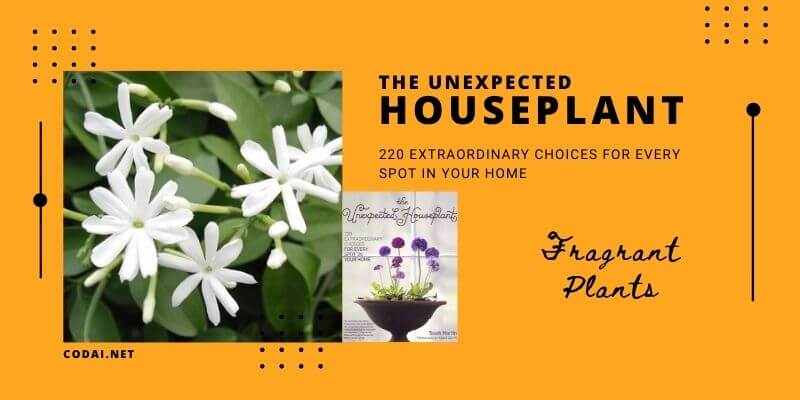[Ebook Việt hóa] The Unexpected Houseplant: 220 Extraordinary Choices for Every Spot in Your Home
[Ebook Việt Hoá] The Unexpected Houseplant: Fragrant Plants (các loại thực vật có mùi hương)
- Nguồn: [Ebook] The Unexpected Houseplant: 220 Extraordinary Choices for Every Spot in Your Home –
- Biên tập: Dũng Cá Xinh (Tháng 02/2022)
- Dịch: Vui Nguyễn
English
FRAGRANT PLANTS
MY HOME ALWAYS smells like plants. In winter, the dense, humid smell of moist soil tends to permeate the place. My living space is a little like an oversize terrarium in that way. That’s the underlying theme, but various flowers layer their top note above that constant voice. That’s what visitors notice when they arrive, but sometimes it all settles into a generic smell of home for me. I notice the aroma of newbies when they first come into blossom, and then it all shifts into the steady beat of the place. And not all flowers throw their wares into the room. I actually prefer the blossoms that keep their scents to themselves until you zero in to sample the goods. Touch your nose to Stephanotis floribunda and you are bound to get a delightful surprise. It’s like your own secret garden, and you can hoard the experience, if you’re inclined. Walk into a room with paperwhites (all it takes is one) and, like it or not, you are exposed to the smell it is spewing forth. Which brings me to another salient issue: not all floral smells are happy marriages with your personal set of sensory prejudices.
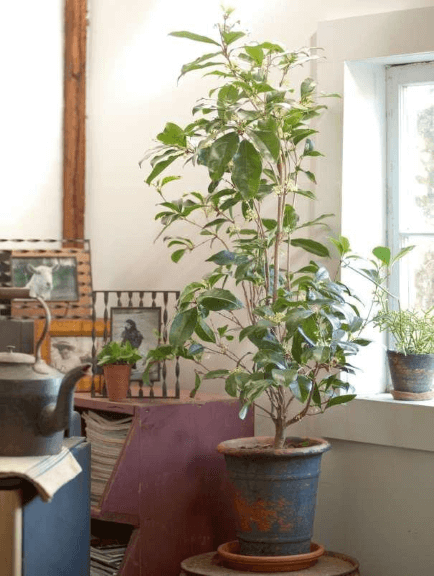
The plants listed aren’t a full roster of all the fragrant plants available for indoor gardeners; they are my personal picks for growing indoors in winter. Not only is winter when you need good scents the most, but it is also when floral essences have their greatest impact. During the rest of the year, you throw the windows open and dilute your own homegrown perfume. In winter, the ecosystem is closed. The combined brew is undiluted by outdoors. It’s a heady and individual affair.
HERMANNIA VERTICILLATA
You would think that honey would be a common floral scent, wouldn’t you? Not the case. Few flowers go that route. But honeybells, Hermannia verticillata, is the essence of pure clover honey. However, if you don’t touch your nose to the blossoms, you will never know.
Even without sampling the wares, the flowers are absolutely adorable. We’re talking small, furled, nodding, canary-yellow flowers about the size of lily-of-the-valley blossoms on trailing stems clad in slender, notched leaves. The flowers occur only in midwinter. Although the plant can be tidy (with pruning to encourage branching) throughout the year, quite frankly, you will never give it a second glance without the flowers.
Bright light is essential for honeybells. A hanging basket might seem to be the obvious route, given the plant’s lax habit, but who has room to hang a plant? I go with a tall pedestal pot or long tom, making sure to rotate and expose the plant to balanced light on all sides. Without sufficient light, you’re apt to court brown spots.
Hermannia verticillata
- HONEYBELLS
| FLOWERS | Masses of tiny, lily-of-the-valley-like, yellow blooms |
| FOLIAGE | Small, notched, and ferny |
| OTHER ATTRIBUTES |
A honey-sweet fragrance |
| SIZE | Dangling |
| EXPOSURE | South |
| WATER REQUIREMENTS |
Medium; try not to moisten the leaves |
| OPTIMUM NIGHTTIME TEMPERATURE |
50–60°F (10–15°C) |
| RATE OF GROWTH | Medium |
| SOIL TYPE | Humusy and well-drained |
| FERTILIZING | Early spring to late autumn, but continue fertilizing in autumn if the foliage pales |
| PROBLEMS | Can get aphids |
PAPERWHITES
Paperwhites are ridiculously easy to grow. Stick the bulb in just about any sort of growing medium, including plain old pebbles (driveway grit will do), and it will sprout. No chilling session is needed (or wanted) for this Mediterranean native. And in no time, green shoots begin to appear. Before you know it, those green shoots have grown long and lanky and are beginning to flop. I have a few solutions. Pack them into the bottom of a deep glass vase and let the rim serve as a support. I also found a chicken-wire cage that was formerly a baffle to protect plants outdoors—the stalks threaded through and stood tall. Those stalks hold buds that swell and pop into snowy clusters of star-shaped blossoms that are quite compelling. The smell of the typical Narcissus papyraceus, however, can be musky (or worse) and not everyone’s favorite. Always in search of a paperwhite that will prove livable, I tried ‘Inbal’ and ‘Ariel’. When only a few buds were open, the scent was mildly pleasant, but it became overpowering in an unpleasant way. As I write this, both plants have been escorted outdoors. There is one golden exception. Also sold as a paperwhite, Narcissus tazetta ‘Grand Soleil d’Or’ stems from different parentage to give it lovely mustard-yellow petals surrounding a small, light orange tube. The scent that comes from that tube is sweet and spicy compared to the heavy, cloying scent of the traditional Narcissus papyraceus clan. It sits only footsteps away, and we’re on extremely friendly terms.

Narcissus papyraceus and Narcissus tazetta
- PAPERWHITES
| FLOWERS | White or yellow open stars in umbels |
| FOLIAGE | Long, thin, grass-like |
| OTHER ATTRIBUTES |
If you like a musky scent, you’ll like paperwhites |
| SIZE | 1–2 feet (30–60cm) in height |
| EXPOSURE | East or west |
| WATER REQUIREMENTS |
When dry |
| OPTIMUM NIGHTTIME TEMPERATURE |
50–60°F (10–15°C) |
| RATE OF GROWTH | Very fast |
| SOIL TYPE | They will tolerate any soil; pebbles will do |
| FERTILIZING | No need for food during their brief moment in the sun |
| PROBLEMS | Not everyone likes the scent. Throw paperwhites onto the compost before they die back and attract aphids. Narcissus are particularly toxic. |
OSMANTHUS FRAGRANS
On the surface, sweet olive (Osmanthus fragrans) is a wholly unremarkable plant with woody stems and glossy green leaves that resemble a sweet bay’s foliage. Don’t misunderstand—it isn’t ugly. But physically, it’s not engaging. The flowers are off-white and so nondescript that you would definitely overlook them if their scent didn’t grab your attention.
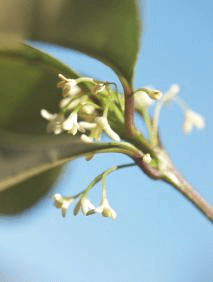
There is no fragrance that compares with the aroma of a sweet olive. It’s like someone sprinkled sugar on the air. It floats gently into your nose, high-pitched and sweet, with perhaps just a hint of spice. You could inhale it all day and never tire of it. When you leave the room, the fragrance calls you back. It’s heaven. Generally in blossom from September through early winter, it eases the liaison between outdoor and indoor gardening.
I used to insist that Osmanthus fragrans was finicky. I used to harp on the special soil it required underfoot and the dangers of fertilizing. Bull. Someone dropped off their plant before moving and I gave it no preferential treatment whatsoever. It thrived. Provide even water and good organic soil, don’t let it get pot-bound, and dose it with fish emulsion, and it will perform beautifully to perfume your home.
Osmanthus fragrans
- ALSO CALLED: fragrant olive, sweet olive
| FLOWERS | Tiny, indistinct white flowers |
| FOLIAGE | Glossy green, bay-like leaves |
| OTHER ATTRIBUTES |
A memorably heady fragrance |
| SIZE | Prune to 2–3 feet (60–90cm) in height |
| EXPOSURE | East or west |
| WATER REQUIREMENTS |
Water regularly; the thick root mass tends to dry out often |
| OPTIMUM NIGHTTIME TEMPERATURE |
50–60°F (10–15°C) |
| RATE OF GROWTH | Slow to medium |
| SOIL TYPE | Rich, well-drained soil mix |
| FERTILIZING | I start in late winter and continue to late autumn |
| PROBLEMS | Prone to scale |
I am an unabashed cheerleader for this vine. Point the finger at the fact that my plant has been in bloom steadily for the last few months or blame it on the tidy, dark green, impeccable leaves—for those reasons and the flower’s fragrance, everyone owes themselves a stephanotis
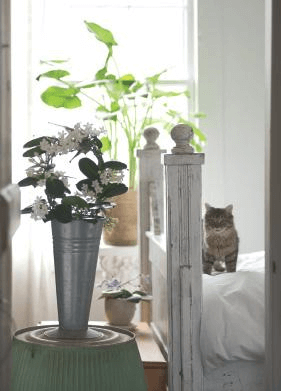
If the long, tubular, white flowers didn’t clue you in that this is a member of the milkweed family, Asclepiadaceae, then the fragrance might drop the hint. Stephanotis flowers don’t send their scent roaming; you discover it only when you touch your nose to a flower cluster. That intimacy yields some tantalizing rewards. The scent is full-bodied and deep, but pleasant in a baby powder sort of way. And the flowers linger over the long haul. Without the stephanotis close up and in constant blossom during winter, my mood would be a whole lot worse.
Stephanotis floribunda
- ALSO CALLED: Madagascar jasmine, waxflower
| FLOWERS | Clusters of long, white tubes |
| FOLIAGE | Oval, deep-green, thick leaves |
| OTHER ATTRIBUTES |
Intensely fragrant; also blooms for the winter holidays |
| SIZE | Rope-like vine is best wound around a loose support or trained in a circle |
| EXPOSURE | South, bright east or west |
| WATER REQUIREMENTS |
Medium |
| OPTIMUM NIGHTTIME TEMPERATURE |
55–65°F (12–18°C) |
| RATE OF GROWTH | Medium |
| SOIL TYPE | Rich, humusy, well-drained soil |
| FERTILIZING | Early spring to late autumn; may need additional fertilizer in winter |
| PROBLEMS | Mealy bugs and scale |
You are probably familiar with the far more readily available Confederate jasmine or pinwheel jasmine, Trachelospermum jasminoides. It is not a jasmine, actually, but its vining habit and star-shaped flowers gave it the nickname. Trachelospermum jasminoides is commonly sold at garden centers as a summer porch plant. Rapidly reaching focal-point proportions (3 to 4 feet [90–122cm]) and holding a smattering of flowers with furled petals (like a pinwheel) through most of the summer, it has earned mainstay status as far as nurseries are concerned. Throw in the soapy scent that the flowers emit, and the pinwheel jasmine gives you yet another reason to become a fan.
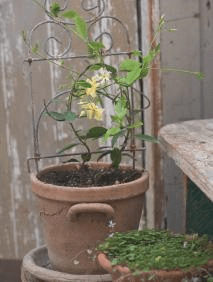
Not many people are familiar with my personal heartthrob, Trachelospermum asiaticum, a demure version of its more prevalent cousin. Its foliage is also dark green and it also wends around as a vine. But in spring, summer, and autumn, it bears creamy yellow blossoms that fill the air with a captivating cinnamony scent. True, it doesn’t blossom in winter, but size-wise it is an easier vine to host over the winter months. And as soon as light levels rev up, the buds will form.
I find that trachelospermums love to be fed. Throw on a little fish emulsion, and they respond by producing buds. They also send up energetic growth, but it’s not a problem. Just wind those vining arms and legs around a trellis. Trachelospermum jasminoides needs a larger container and a sturdier support than Trachelospermum asiaticum, but both are trouble free.
Trachelospermum asiaticum and Trachelospermum jasminoides
- ALSO CALLED: pinwheel jasmine, star jasmine
| FLOWERS | Stars with furled petals, white to cinnamon-colored |
| FOLIAGE | Tidy, glossy green leaves |
| OTHER ATTRIBUTES |
The fragrance is a delight |
| SIZE | Smaller vine for Trachelospermum asiaticum, larger vine for Trachelospermum jasminoides |
| EXPOSURE | East or west |
| WATER REQUIREMENTS |
Medium |
| OPTIMUM NIGHTTIME TEMPERATURE |
50–60°F (10–15°C) |
| RATE OF GROWTH | Medium to fast-growing vine |
| SOIL TYPE | Rich, humusy, well-drained soil mix |
| FERTILIZING | Early spring to late autumn |
| PROBLEMS | Scale can be an issue |
Tiếng Việt
CÁC LOẠI THỰC VẬT CÓ MÙI HƯƠNG
Nhà tôi luôn ngập tràn mùi cây cỏ. Vào mùa đông, hơi nước ẩm ướt, dày đặc bao quanh vào nơi này. Do đó, không gian sống của tôi trông giống một chiếc terrarium ngoại cỡ. Ngôi nhà là một bản nhạc, các loài hoa khác nhau là những nốt nhạc trên bản nhạc không đổi đó. Đó là những gì du khách nhìn thấy khi họ đến đây, nhưng đôi khi đối với tôi, tất cả đọng lại tạo thành mùi hương gia đình. Tôi nhận ra mùi thơm của những bông hoa mới nở, và sau đó tất cả chuyển sang nhịp điệu ổn định vốn có ở nơi này. Và không phải tất cả các loại hoa đều được đặt trong phòng. Tôi thực sự thích những bông hoa giữ mùi hương lâu. Chạm mũi vào Stephanotis floribunda, chắc chắn bạn sẽ bất ngờ. Nó giống như khu vườn bí mật của riêng bạn và bạn có thể tích lũy kinh nghiệm, nếu muốn. Bước vào một căn phòng có hoa Thủy tiên trắng, dù muốn hay không, bạn cũng phải tiếp xúc với mùi hương mà nó tỏa ra. Từ đây chúng ta lại đến với một vấn đề khác: không phải mùi hương nào cũng khiến bạn cảm thấy hạnh phúc khi bạn vốn dĩ đã có định kiến cá nhân với chúng.

Những loại cây được liệt kê dưới đây vẫn chưa phải là danh sách đầy đủ về các loại cây có mùi thơm dành cho những người trồng cây trong nhà; chúng là loại cây tôi thấy thích hợp trồng vào mùa đông. Mùa đông không chỉ là lúc bạn cần những mùi hương thơm mát mà còn là lúc hoa có tác động mạnh nhất tới bạn. Trong thời gian còn lại của năm, bạn mở tung cánh cửa sổ và lan tỏa hương hoa thơm ngát trong căn nhà. Vào mùa đông, hệ sinh thái như ngừng hoạt động. Hương hoa không bị lan tỏa khi ở ngoài trời. Đó là một công việc riêng biệt và khó khăn.
HERMANNIA VERTICILLATA
Bạn sẽ nghĩ rằng mật hoa sẽ có hương hoa, phải không? Không phải vậy. Rất ít loại hoa đi theo còn đường đó. Nhưng Honeybells (Hermannia verticillata), có mùi hương mật hoa tự nhiên. Tuy nhiên, nếu bạn không chạm mũi vào những bông hoa đó, bạn sẽ không bao giờ biết được.
Ngay cả khi không thưởng thức mùi hương đó, những bông hoa này vẫn rất đáng yêu. Chúng ta đang nói về những bông hoa màu vàng hoàng yến nhỏ, có lông, rủ xuống, có kích thước tương đương với những bông hoa Linh lan trên những thân cây dài, có lá mảnh hình chữ V. Những bông hoa này chỉ xuất hiện vào giữa mùa đông. Mặc dù cây trông khá gọn gàng (cắt tỉa để khuyến khích cây phân nhánh) trong suốt cả năm, nhưng thành thật mà nói, bạn sẽ không bao giờ liếc nhìn nó lần thứ hai nếu nó không có hoa.
Honeybell rất cần ánh sáng mạnh. Tôi trồng nó trong chậu có bệ cao hoặc chậu dài để có thể di chuyển và để cây tiếp xúc với ánh sáng ở mọi phía. Nếu không có đủ ánh sáng, nó sẽ bị đốm nâu.
Hermannia verticillata
- HONEYBELL
| HOA | hoa nhỏ, có màu vàng giống như hoa Linh lan |
| LÁ | nhỏ, hình chữ V |
| THUỘC TÍNH KHÁC | hương thơm ngọt ngào như mật ong |
| KÍCH THƯỚC | hoa rủ xuống |
| ÁNH SÁNG | phía nam |
| YÊU CẦU VỀ NƯỚC | trung bình, không làm ướt quá |
| NHIỆT ĐỘ TỐI ƯU BAN ĐÊM | 50–60 ° F (10–15 ° C) |
| TỐC ĐỘ PHÁT TRIỂN | trung bình |
| LOẠI ĐẤT | đất mùn và thoát nước tốt |
| BÓN PHÂN | đầu mùa xuân đến cuối mùa thu, tiếp tục bón phân vào mùa thu nếu tán lá nhạt màu |
| VẤN ĐỀ | có thể bị rệp |
THỦY TIÊN TRẮNG (PAPERWHITE)
Thủy tiên trắng rất dễ trồng. Chỉ cần vùi củ vào bất kỳ loại đất trồng nào, kể cả trồng ở nơi có những viên sỏi cũ mộc mạc, nó vẫn nảy mầm. Không cần làm lạnh loại cây Địa Trung Hải bản địa này trước khi trồng. Chỉ cần vùi xuống đất, chồi xanh sẽ xuất hiện. Trước khi bạn biết điều đó, những chồi xanh này đã dài ra, cao lêu nghêu và đang bắt đầu rũ xuống. Tôi có một vài giải pháp. Vùi chúng dưới đáy bình thủy tinh sâu. Tôi cũng tìm thấy mảnh lưới trước đây được dùng làm vách ngăn để bảo vệ thực vật ở ngoài trời — những thân cây này đã luồn qua và vươn cao. Trên thân cây có những cụm hoa hình ngôi sao màu trắng tuyết trông khá hấp dẫn. Tuy nhiên, mùi hương điển hình của Narcissus papyraceus là mùi xạ hương (hoặc tệ hơn) do đó không phải ai cũng thích nó. Khi chỉ mới hé nở một vài nụ, mùi hương vốn nhẹ nhàng dễ chịu đã lấn át căn phòng khiến tôi hơi khó chịu. Khi tôi viết bài này, cả hai loại cây đó đã được hộ tống ra ngoài. Có một loại Thủy tiên vàng có hình dạng giống Thủy tiên trắng tên là Narcissus tazetta ‘Grand Soleil d’Or’, nó có nguồn gốc khác với Thủy tiên trắng, với những cánh hoa màu vàng mù tạt đáng yêu bao quanh một ống nhỏ màu cam nhạt. Mùi hương tỏa ra từ ống tràng vừa ngọt vừa cay so với mùi quá đậm và ngọt của họ Narcissus papyraceus truyền thống. Dù ngồi cách vài bước chân nhưng chúng tôi đã có mối quan hệ cực kì thân thiện.

Narcissus papyraceus và Narcissus tazetta
- THỦY TIÊN TRẮNG
| HOA | hoa màu trắng hoặc màu vàng mọc theo cụm |
| LÁ | dài, mảnh, giống lá cỏ |
| THUỘC TÍNH KHÁC | nếu bạn thích mùi xạ hương, bạn sẽ thích Thủy tiên trắng |
| KÍCH THƯỚC | chiều cao 1–2 feet (30–60cm) |
| ÁNH SÁNG | phía Đông hoặc Tây |
| YÊU CẦU VỀ NƯỚC | tưới khi đất khô |
| NHIỆT ĐỘ TỐI ƯU BAN ĐÊM | 50–60 ° F (10–15 ° C) |
| TỐC ĐỘ PHÁT TRIỂN | nhanh |
| LOẠI ĐẤT | bất kì loại đất nào, đất sỏi cũng được |
| BÓN PHÂN | không bón phân trong giai đoạn cây phơi nắng |
| VẤN ĐỀ | Không phải ai cũng thích mùi hương của nó. Đào Thủy tiên trắng ra khỏi đất để tránh thu hút rệp. Thủy tiên trắng đặc biệt độc. |
CÂY MỘC (OSMANTHUS FRAGRANS)
Nhìn bề ngoài, cây Mộc (Osmanthus aromans) là một loài cây không có gì nổi bật. Nó có thân gỗ và lá xanh trông giống như tán lá của cây Vàng tâm. Đừng hiểu lầm, không phải là nó không xấu xí. Mà về mặt diện mạo, trông nó không hấp dẫn. Những bông hoa này có màu trắng nhạt, kém lôi cuốn, nếu không có mùi hương thì chúng sẽ không thu hút được sự chú ý của bạn.

Không có mùi hương nào sánh được với mùi thơm của nó cả. Mùi hương đó giống như có ai rải đường từ không trung xuống. Nó nhẹ nhàng bay vào cánh mũi, hơi gai gai và ngọt ngào. Bạn có thể hít hà hương thơm đó cả ngày mà không biết mệt. Khi bạn rời khỏi phòng, mùi hương thơm ngát đó sẽ gọi bạn lại. Đó là thiên đường. Thông thường, hoa Mộc nở từ tháng 9 đến đầu mùa đông, nó làm giảm bớt mối liên hệ giữa làm vườn ngoài trời và trong nhà.
Tôi đã từng nhấn mạnh rằng hoa Mộc tạo ra một mùi hương kỳ quặc. Tôi đã từng nói liên tục về một loại đất đặc biệt và sự nguy hiểm của việc bón phân. Ai đó đã vứt bỏ cái cây đó trước khi họ chuyển đi, tôi đã lượm nó về và không hề đối xử ưu tiên với nó. Nó phát triển rất mạnh. Chỉ cần bạn cung cấp nước đều đặn, trồng nó trên đất hữu cơ tốt, không để nó sống quá chật chội, và bón đạm cá, nó sẽ phát triển tốt và tạo hương thơm cho ngôi nhà.
Cây Mộc
- HAY CÒN GỌI LÀ: fragrant olive, sweet olive
| HOA | hoa nhỏ, màu trắng nhạt |
| LÁ | Lá xanh bóng, giống lá nguyệt quế |
| THUỘC TÍNH KHÁC | mùi hương nhẹ nhàng, đáng nhớ |
| KÍCH THƯỚC | cao đến 2–3 feet (60–90cm) khi đã cắt tỉa |
| ÁNH SÁNG | phía Đông và phía Tây |
| YÊU CẦU VỀ NƯỚC | tưới nước thường xuyên; lượng rễ nhiều nên thường xuyên khô |
| NHIỆT ĐỘ TỐI ƯU BAN ĐÊM | 50–60 ° F (10–15 ° C) |
| TỐC ĐỘ PHÁT TRIỂN | chậm đến trung bình |
| LOẠI ĐẤT | đất giàu chất dinh dưỡng, thoát nước tốt |
| BÓN PHÂN | bắt đầu vào cuối mùa đông và tiếp tục đến cuối mùa thu |
| VẤN ĐỀ | bọ vảy |
Tôi không hề ngần ngại cổ vũ cho loại cây này. Nhìn vào thực tế bạn sẽ thấy, cây Nhài leo của tôi nở hoa đều đặn trong vài tháng qua, ấy thế mà tán lá vẫn gọn gàng, màu xanh đậm và hoàn hảo. Vì những lý do và hương thơm đó, mọi người đều nên sở hữu cho mình một cây Nhài leo.

Nếu những bông hoa dài, hình ống, màu trắng này vẫn chưa cho bạn đủ manh mối để biết rằng đây có phải là một thành viên của họ Bông tai (Asclepiadaceae) hay không, mùi hương sẽ cho bạn biết. Hoa của cây thân leo không phát tán mùi hương đi xa; bạn chỉ phát hiện ra nó khi bạn chạm mũi vào một cụm hoa. Sự gần gũi đó mang lại một số phần thưởng hấp dẫn. Mùi hương sâu, nhưng dễ chịu giống như sữa bột trẻ em. Và những bông hoa thì nở trong thời gian dài. Nếu không có những cây thân leo gần gũi và liên tục nở hoa trong suốt mùa đông, tâm trạng của tôi sẽ rất tệ.
Nhài leo
- CÒN ĐƯỢC GỌI LÀ: Hoa nhài Madagascar, hoa sáp
| HOA | cụm ống hoa dài, màu trắng |
| LÁ | lá hình bầu dục, màu xanh đậm, dày |
| THUỘC TÍNH KHÁC | thơm nồng; nở hoa trong cả những ngày đông |
| KÍCH THƯỚC | là dạng cây leo nên được quấn quanh giá đỡ hoặc uốn thành vòng tròn |
| ÁNH SÁNG | hướng Nam, hướng Đông hoặc Tây sáng |
| YÊU CẦU VỀ NƯỚC | trung bình |
| NHIỆT ĐỘ TỐI ƯU BAN ĐÊM | 55–65 ° F (12–18 ° C) |
| TỐC ĐỘ PHÁT TRIỂN | trung bình |
| LOẠI ĐẤT | đất nhiều mùn, thoát nước tốt |
| BÓN PHÂN | đầu mùa xuân đến cuối mùa thu; có thể bón thêm phân vào mùa đông |
| VẤN ĐỀ | rệp sáp và bọ vảy |
THẰN LẰN CẨM THẠCH (TRACHELOSPERMUM ASIATICUM)
Có thể bạn đã quá quen thuộc với hoa Nhài sao, hay còn có tên Trachelospermum jasminoides. Thực ra đây không phải là hoa Nhài, do thói quen leo với những bông hoa hình ngôi sao đã mang cho nó cái tên như thế. Nhài sao thường được bán ở các trung tâm làm vườn để làm cây trồng dưới hiên nhà vào mùa hè. Nó nhanh chóng phát triển đến độ ra hoa (90–122cm) và bừng nở với những cánh hoa cuộn lại (giống như một cái chong chóng) mùa hè đến, nó trở thành trụ cột của các vườn ươm. Nép mình trong hương thơm giống như xà phòng mà nó tỏa ra, Nhài sao đã mang đến cho bạn thêm một lý do để trở thành người hâm mộ của nó.

Không nhiều người quen thuộc với kẻ đã đánh cắp trái tim tôi – Thằn lằn cẩm thạch, đây là phiên bản kinh dị của những người anh em họ Nhài nổi tiếng hơn. Nó có tán lá màu xanh đậm và cũng uốn lượn như một cây leo. Nhưng vào mùa xuân, mùa hè và mùa thu, nó nở ra những bông hoa màu vàng kem với hương thơm quyến rũ của quế tràn ngập trong không khí. Đúng vậy, nó không nở hoa vào mùa đông, nhưng nó là một loại cây leo dễ sống trong những tháng mùa đông. Và ngay sau khi cường độ ánh sáng tăng lên, các chồi non sẽ hình thành.
Tôi thấy rằng chúng rất thích được bón phân. Hãy bón cho chúng một ít đạm cá, chúng sẽ đáp trả bạn bằng những chồi non. Chúng cũng phát triển khá mạnh, nhưng đó không phải là vấn đề. Bạn chỉ cần quấn tay leo lên quanh giàn là được. Nhài sao cần chậu cây lớn và một giá đỡ chắc chắn hơn Thằn lằn cẩm thạch, nhưng cả hai đều không gặp nhiều vấn đề lớn.
Thằn lằn cẩm thạch và Nhài sao
- CÒN GỌI LÀ: pinwheel jasmine, star jasmine
| HOA | cánh hoa xoăn, hoa hình ngôi sao, màu trắng đến màu quế |
| LÁ | tán lá xanh bóng, gọn |
| THUỘC TÍNH KHÁC | mùi hương mang đến cảm giác vui vẻ |
| KÍCH THƯỚC | Thằn lằn cẩm thạch leo rộng hơn, Nhài sao leo hẹp hơn |
| ÁNH SÁNG | phía Đông hoặc Tây |
| YÊU CẦU VỀ NƯỚC | trung bình |
| NHIỆT ĐỘ TỐI ƯU BAN ĐÊM | 50–60 ° F (10–15 ° C) |
| TỐC ĐỘ PHÁT TRIỂN | từ trung bình đến nhanh |
| LOẠI ĐẤT | đất giàu mùn, thoát nước tốt |
| BÓN PHÂN | đầu mùa xuân đến cuối mùa thu |
| VẤN ĐỀ | bọ vảy có thể gây ra vấn đề |
